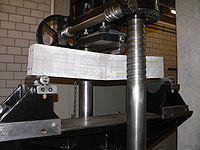
Photo from wikipedia
Abstract The delamination failure of a composite laminate under a flexural load was repaired by micro-bolts and adhesive resin. The specimens were made by autoclave processing, and in the prepreg-stacking… Click to show full abstract
Abstract The delamination failure of a composite laminate under a flexural load was repaired by micro-bolts and adhesive resin. The specimens were made by autoclave processing, and in the prepreg-stacking step, a Teflon release film was inserted to mimic the delamination in the specimens. Bolts made with brass or steel were used in the micro-bolt repair method, and the diameters of bolts were 0.6, 1.0, and 1.2 mm. For the resin injection repair method, the EA9396, a low-viscosity and room-temperature curing epoxy adhesive, was used as the repair material. In the case of the micro-bolt repair method, although the larger bolt resulted in higher bending strength, the difference in bending strength of the repaired specimens, depending on bolt diameter, was insignificant. The difference in bending strength was only 21% when 0.6-mm and 1.2-mm diameter bolts were installed. On the other hand, the bending strength of the specimens, repaired by the resin injection method, was recovered, up to 93% of the pristine specimen. From the results of this study, it was confirmed that the resin-injection repair, which injects resin into the delamination to bond the entire separated surface area, is more effective than using micro-bolts if the flexural load is predominant.
Journal Title: Composite Structures
Year Published: 2019
Link to full text (if available)
Share on Social Media: Sign Up to like & get
recommendations!